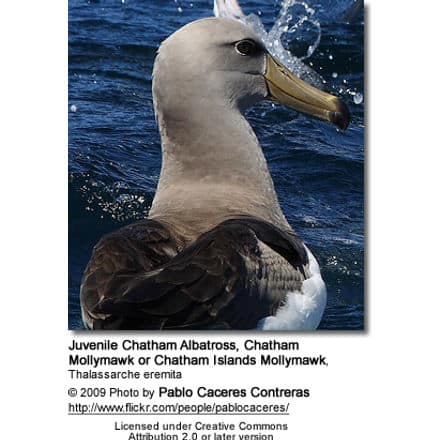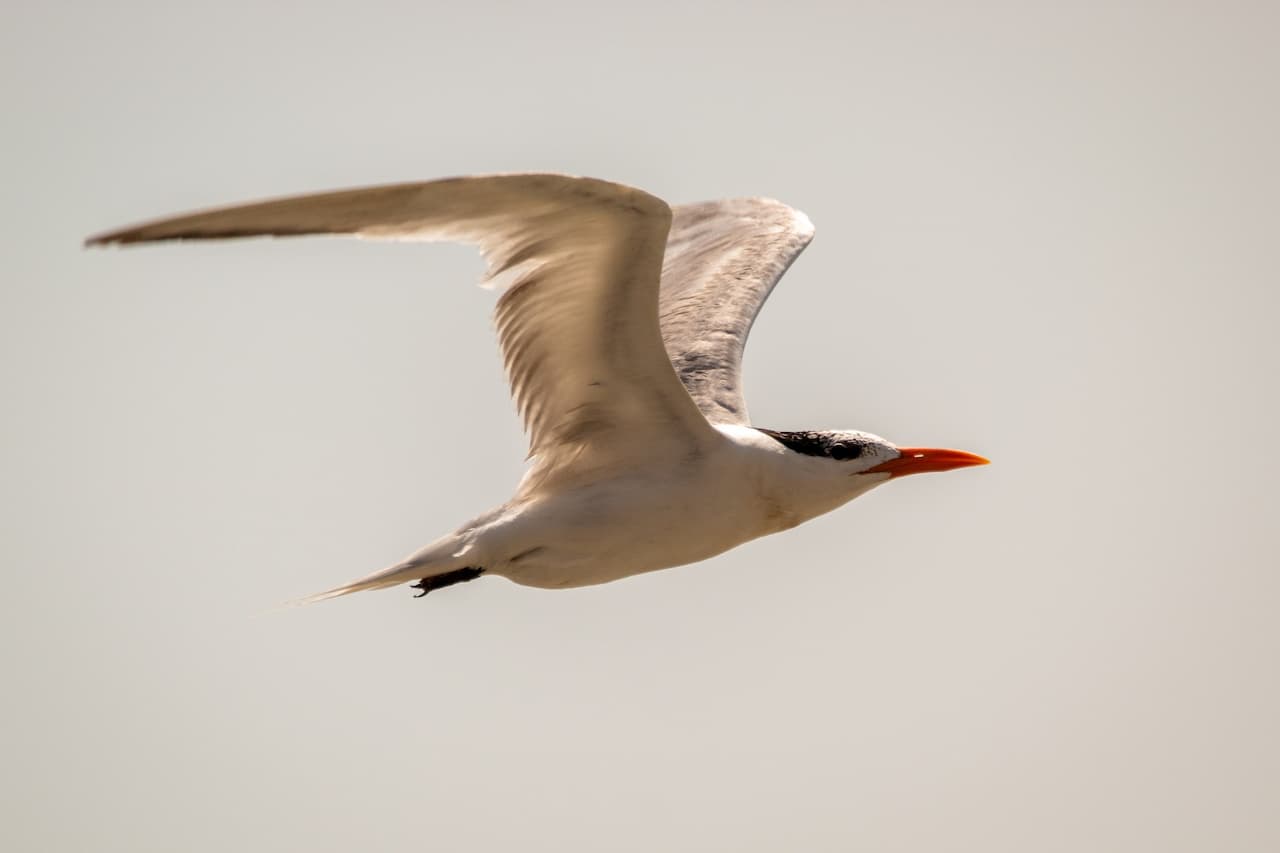Chatham Albatrosses, Chatham Mollymawks, or Chatham Islands Mollymawks
Albatross Information
The Chatham Albatrosses, Chatham Mollymawk, or Chatham Islands Mollymawk, Thalassarche eremita, is a medium-sized black-and-white albatross that breeds only on The Pyramid, a large rock stack in the Chatham Islands, New Zealand. It is sometimes treated as a subspecies of the Shy Albatross Thalassarche cauta. It is the smallest of the Shy Albatross group.
Description
The Chatham Albatrosses weighs 3.1–4.7 kg (6.8–10 lb) and it has a length of 90 cm (35 in).
The adult has a dark grey crown, face, upper mantle, back, upperwing, tail, and throat. They have a white rump and underparts. They also have a black thumbmark on the leading edge of the underwings, and a black tip on the wings. Their bill is yellow with a dark spot on the tip of the lower mandible (bill). Finally, they have an orange cheek stripe. The juveniles have more extensive grey and their bill is blue-grey with black tips on both mandibles.
Behavior
They are normally silent, but will emit a harsh buzzing bray when threatened and also during courtship. Besides the sound they will put on a courtship display which includes fanning of the tail, mutual jousting of bills, and grunting.
Range and habitat
The Chatham Albatross nests only on The Pyramid in the Chatham Islands. Using aerial photography, in 1998, scientists estimated that there were between 3,200 and 4,200 pairs nesting. Ground counts from 1999 to 2003 increased this number to 5,300 pairs for a total of approximately 11,000 breeding age birds. When not breeding they range in the South Pacific from Tasmania to Chile and Peru. From April to July they will utilize the Humboldt Current and go as far north as 6°S along the South American coast
| Location | Population | Date | Trend |
| The Pyramid Chatham Islands | 5,300 pair | 2003 | Stable |
| Total | 11,000 | 2003 | Stable |
Reproduction
This species of Albatross breeds annually on rocky ledges, steep slopes, and crevices. They build pedestal nests of soil and vegetation. At this time, The Pyramid in the Chatham Islands is the only island that they use for nesting. They lay their one egg between 20 August and 1 October, with the egg hatching in November or December, after 68–72 days. The chicks fledge by March or April, or 130 to 140 days after hatching. Juveniles will return to the colony after 4 years, but won’t breed until the 7th year.
Feeding
The Chatham Albatross feeds on fish, cephalapods, krill, and barnacles.
Conservation
The IUCN has classified this species as Critically Endangered, due to the fact that they nest on one small island, which as undergone significant decline in habitat condition. In 1985 a severe storm impacted the island by reducing the amount of vegetation on the island. The conditions have been improving since 1998. As with other albatrosses, commercial fishing impacts their survival, with longline and the occasional trawl line. Illegal harvesting of chicks occurs in small amounts.
Taxonomy
Mollymawks are a type of Albatross that belong to Diomedeidae family and come from the Procellariiformes order, along with Shearwaters, Fulmars, Storm-petrels and Diving-petrels. They share certain identifying features. First, they have nasal passages that attach to the upper bill called naricorns. Although the nostrils on the Albatross are on the sides of the bill. The bills of Procellariiformes are also unique in that they are split into between 7 and 9 horny plates. Finally, they produce a stomach oil made up of wax esters and triglycerides that is stored in the proventriculus (stomach). This is used against predators as well as an energy rich food source for chicks and for the adults during their long flights. They also have a salt gland that is situated above the nasal passage and helps desalinate their bodies, due to the high amount of ocean water that they imbibe. It excretes a high saline solution from their nose.
The Chatham Albatross along with the White-capped Albatross, Shy Albatross, and Salvin’s Albatross were all considered the same species until a 1998 book by Robertson and Nunn. Other experts followed suit, with BirdLife International in 2000, Brooke in 2004, ACAP (Agreement on the Conservation of Albatrosses and Petrels) in 2006, and American Ornithologists’ Union (SACC) in 2008. Though some, like James Clements, still don’t agree.
The Chatham Albatross was first described as Diomedea cauta eremita by Robert Cushman Murphy, in 1930, based on a specimen from Pyramid Rock, Chatham Islands.
Copyright: Wikipedia. This article is licensed under the GNU Free Documentation License. It uses material from Wikipedia.org … Additional information and photos added by Avianweb.
Photo, Video and/or Article contributions are welcome! Upload articles and images.
Please Note: The images on this page are the sole property of the photographers (unless marked as Public Domain). Please contact the photographers directly with respect to any copyright or licensing questions. Thank you.





